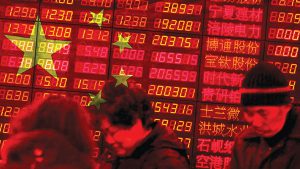BLOOMBERG
Chinese shares dragged down Asian equities on the first trading day of the year following weaker-than-expected factory data and a speech from President Xi Jinping that flagged the headwinds facing the economy. Crude oil rose. Hong Kong’s benchmark share gauge slid as much as 1.7%, while its peers in the mainland and Taiwan also dropped. The losses drove a regional equity benchmark toward its first decline in seven days.
Chinese factory activity shrank in December to the lowest level in six months, data showed, while a private gauge of manufacturing released on Tuesday showed a slight gain. Sluggish activity in the world’s second-largest economy also contributed to a slump in factories across Asia.
President Xi in his annual new year address pledged to strengthen economic momentum and job creation, while conceding some “enterprises had a tough time” and “people had difficulty finding jobs and meeting basic needs.” China’s economy may face another tough year in 2024, said Mark Matthews, head of Asia research at Julius Baer. “President
Xi has made it very clear that on the economic front, his priority is bringing down the size of the property sector and its importance in the economy,” he said on Bloomberg Television. “That process is painful.”
Oil gained. Sentiment in Asia was also dented after people familiar said ASML Holding NV, which makes semiconductor manufacturing equipment, canceled shipments of some of its machines to China at the request of US President Joe Biden’s administration. US stock futures were little changed. The yen weakened against most of its Group-of-10 peers in thin trading as investors monitored conditions after an earthquake in Japan on January 1. US 10-year note futures dropped, while cash Treasuries are shut in Asia for a holiday in Japan. Australian bonds slipped.
Bitcoin climbed above $45,000 for the first time in nearly two years as anticipation of an approval of an exchange-traded fund investing directly in the biggest token
intensified.
Rising Risks
Signs of exhaustion have emerged after a more than $8 trillion surge in the S&P 500 last year. Traders have looked past Federal Reserve uncertainty, recession angst and geopolitical risks.
And many who came into 2023 dreading all that have ended up scrambling to chase the rally.
“With an especially rare S&P nine-week winning streak already in the books, the index into resistance near the 4,800 level, and daily and weekly overbought readings, too, these factors combine to say we should expect some type of a consolidation, correction, or pullback — something,” John Roque, technical analyst at 22V Research, wrote in a note.
Meanwhile, despite the persisting weakness in China, some investors consider a slump of almost 60% is a signal to buy Chinese stocks. Almost a third of 417 respondents to Bloomberg’s latest Markets Live Pulse survey say they will increase their China investments over the next 12 months. That compares with just 19% in a similar August survey and is higher than the 25% who planned to boost exposure in March.
 The Gulf Time Newspaper One of the finest business newspapers in the UAE brought to you by our professional writers and editors.
The Gulf Time Newspaper One of the finest business newspapers in the UAE brought to you by our professional writers and editors.
